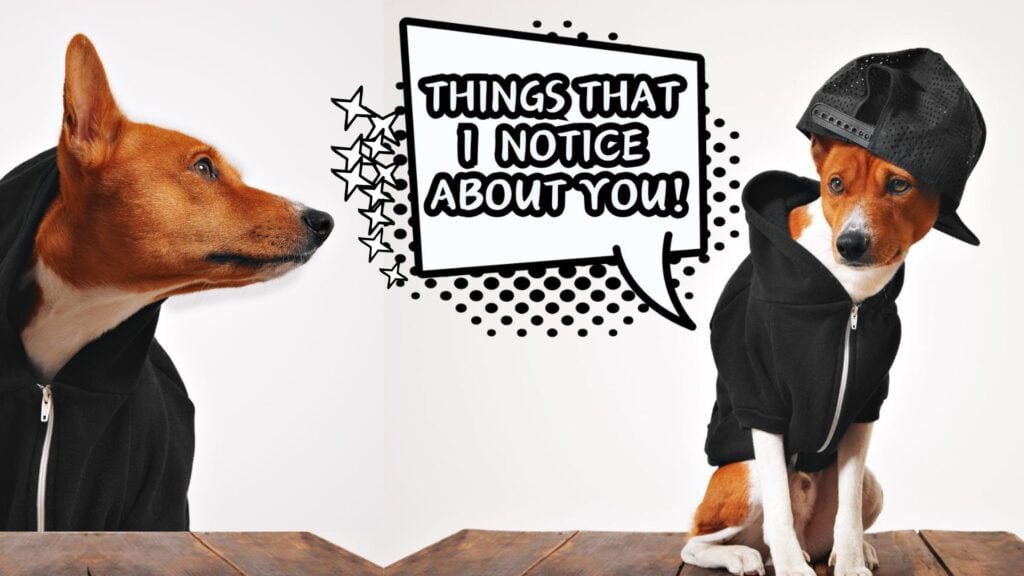Imagine the rhythm of your feet hitting the trail, the sound of steady panting beside you, and the gentle pull of a harness connecting you to your furry friend as a running partner. This is the world of cross country running with dogs, a sport that transforms your daily jog into an adventure of mutual endurance and joy. Canicross, the official term for cross country running with dogs, has evolved from sled dog training into a popular outdoor activity that strengthens the bond between humans and their four-legged athletes while providing exceptional physical and mental stimulation.
The beauty of cross country running with dogs lies in its simplicity, a human, a dog, and a trail, but mastering this sport requires knowledge, preparation, and understanding of your dog’s capabilities. Whether you’re running with a speedy Siberian Husky, an athletic German Shorthaired Pointer, or a energetic Border Collie, the principles of endurance running remain the same. Proper training, appropriate gear, and mutual communication. The journey from casual runner to canicross team is filled with discovery, challenges, and incredible rewards that go far beyond physical fitness.
In this comprehensive guide, we’ll explore everything you need to know about cross country running with dogs, from its historical origins to modern-day training techniques. We’ll examine the best breeds for the sport, share essential safety tips, and provide you with a practical training plan to begin your adventure. Whether you’re looking to compete in organized events or simply enjoy trail time with your dog, this article will help you and your canine partner become the ultimate running team.
„Discover the sport that transforms your faithful companion into your most powerful training partner,
and turns every path into a shared adventure.“
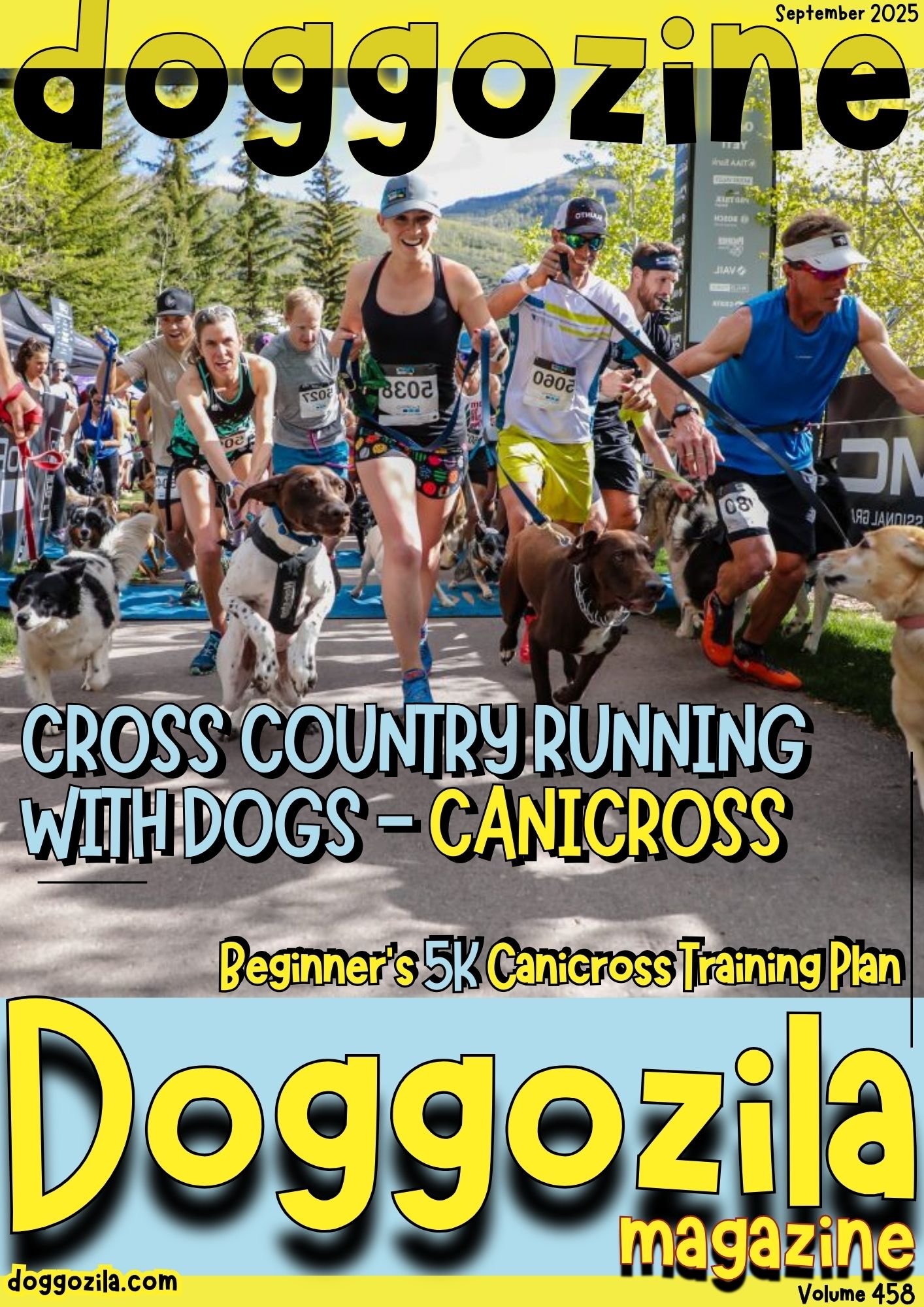
THE ORIGINS AND EVOLUTION OF CROSS COUNTRY RUNNING WITH DOGS (CANICROSS)
Cross country running with dogs has a fascinating history that dates back several decades. The sport originated in Europe as an off-season training method for mushers and their sled dog teams. When snow was scarce, mushers would keep their dogs in peak physical condition by having them pull humans while running instead of pulling sleds. This practical training solution quickly evolved into a formal sport called canicross, a combination of “canine” and “cross country“, that gained popularity throughout Europe before spreading to North America and other parts of the world.
The transition from training method to organized sport began in the early 2000s, with the first official canicross event in the UK taking place in 2000. By 2006-2007, the UK hosted its first National Championship, and in March 2008, canicross made its debut at Crufts, the world’s largest dog show. The sport’s international recognition grew when the UK hosted the first European Canicross Championships in October 2012 in Cirencester, Gloucestershire. What began as a niche activity for sled dog enthusiasts has now become a mainstream sport enjoyed by people with all types of dogs who enjoy running.
What is Canicross and How This Sport Has Grown Today?
Today, cross country running with dogs (Canicross) has evolved beyond its sled dog origins to include a diverse community of runners and their canine companions. The sport continues to grow through organizations such as North American Canicross, the United States Federation of Sleddog Sport.
Various regional clubs host these sport events and provide resources for enthusiasts. Modern canicross events range from short-distance sprints of one mile to extreme endurance challenges covering 28 miles or more, accommodating teams of all skill levels and abilities.
The Basic Concept of Canicross
The fundamental concept behind cross country running with dogs is simple yet revolutionary, instead of holding your dog back on a leash, your canine partner runs ahead and provides a gentle pull that assists your movement. This setup creates a symbiotic relationship where both runner and dog can move more naturally and efficiently.
The dog wears a specially designed pulling harness that distributes force evenly across their body, while the human wears a waist belt connected to the dog via a bungee leash that absorbs shock and provides comfortable resistance for both team members.
Why Canicross Benefits Both Species?
Engaging in cross country running with dogs offers numerous physical and psychological benefits for both humans and canines. For dogs, it provides an outlet for natural instincts to run and pull, reduces destructive behaviors caused by pent-up energy, and promotes cardiovascular health.
For humans, it adds motivation to exercise regularly, provides assistance during uphill runs, and strengthens the bond with their pet. The mental health benefits are equally significant, with both species experiencing reduced stress levels and increased happiness from shared outdoor activity and teamwork.
The Growing Community of Canicross Enthusiasts
The community surrounding cross country running with dogs has expanded rapidly in recent years, with clubs and organizations now established across Europe, North America, and beyond. Social media groups, training workshops, and organized events have created a supportive network where beginners can learn from experienced canicrossers. This community aspect transforms the sport from a solitary activity into a social experience where both humans and dogs can make new friends who share their passion for running and adventure.
🔑 Key Points: Canicross, now known as cross country running with dogs, began as an off-season training method for sled dog teams in Europe before evolving into the popular organized sport it is today.
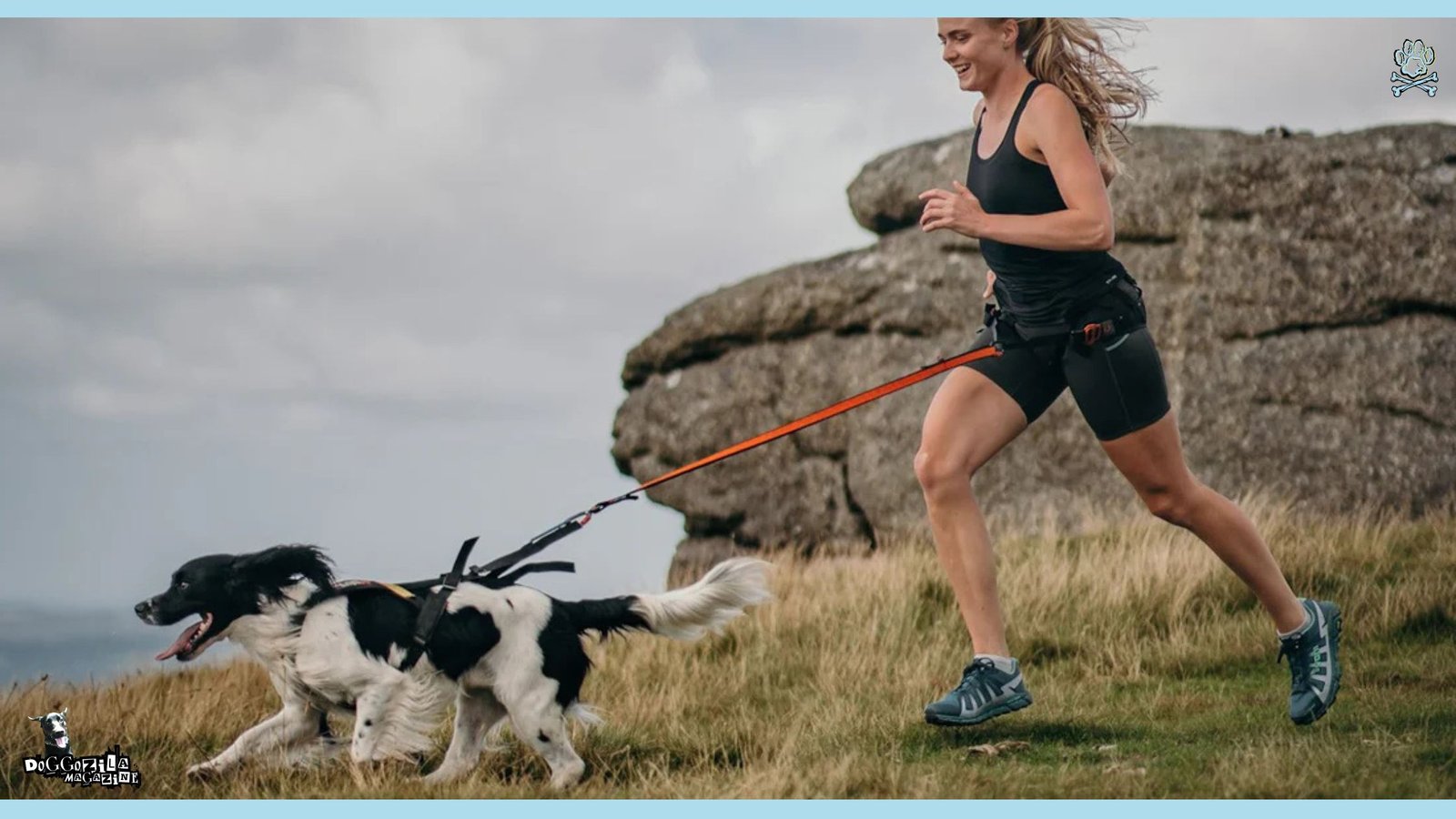
ESSENTIAL GEAR FOR CROSS COUNTRY RUNNING WITH DOGS
Having the right equipment is crucial for safe and enjoyable cross country running with dogs. The basic gear system consists of three components, a specialized harness for your dog, a comfortable waist belt for yourself, and a shock-absorbing line that connects you both. Regular dog walking equipment is not suitable for canicross, as it doesn’t provide proper support, freedom of movement, or safety features needed for running together. Investing in quality gear designed specifically for the sport will prevent injuries and enhance the experience for both you and your canine partner.
The most important piece of equipment is your dog’s harness. Unlike standard harnesses that may restrict movement or create pressure points, a proper canicross harness is designed specifically for pulling. It should distribute force evenly across your dog’s body, allow full range of motion in the shoulders and elbows, and not interfere with breathing. Different breeds may require different harness styles, X-back harnesses are popular for traditional sled dog breeds, while other designs may work better for different body types. Proper fit is essential to prevent chafing and discomfort during long runs.
What is The Human Component of The Gear System?
The human component of the gear system is a waist belt designed to stay securely in place during running. These belts typically feature padding for comfort, leg straps to prevent riding up, and a reinforced attachment point for the bungee line.
Wearing the belt around your waist rather than holding a leash in your hands allows for better balance, more natural running form, and prevents arm fatigue. It also keeps your hands free for balance adjustments or drinking water during runs, making your cross country running with dogs’ experience safer and more enjoyable.
Selecting the Right Canicross Harness
Choosing the perfect harness for cross country running with dogs requires consideration of your dog’s breed, body shape, and pulling style. Measure your dog carefully, noting the girth behind the elbows, the length from withers to tail, and the neck circumference. Many companies offer breed-specific designs or customizable options.
Test the harness with short runs before committing to long distances, and watch for any signs of discomfort, rubbing, or restricted movement. Remember that a well-fitted harness should not cause any hair loss or skin irritation even after extended use.
The Importance of Bungee Lines
The connection between you and your dog during cross country running with dogs is more than just a leash, it’s a critical safety feature. Bungee lines with shock-absorbing properties protect both runner and dog from sudden jolts that can occur when changing pace or direction.
These specialized lines stretch to absorb impact when your dog pulls suddenly, preventing shoulder injuries to humans and neck injuries to dogs. Most are between 6-10 feet long, providing enough distance for safe movement while maintaining control. The bungee line truly exemplifies the teamwork inherent in country running with dogs.
Additional Safety Gear for Trail Running
When embarking on cross country running with dogs, additional safety items can make a significant difference in your experience. For evening runs, reflective gear or LED lights help both of you remain visible to others. During hot weather, cooling vests or bandanas can prevent overheating.
Always carry water for both species, portable bowls or hands-free water systems are ideal. A basic canine first aid kit containing paw protection, bandages, and antiseptic is essential for longer trails. These precautions ensure that your country running with dogs remains safe and enjoyable.
🔑 Key Points: Proper equipment is non-negotiable for safety and consists of three specialized components: a pulling harness for the dog, a waist belt for the human, and a shock-absorbing bungee line that connects them.
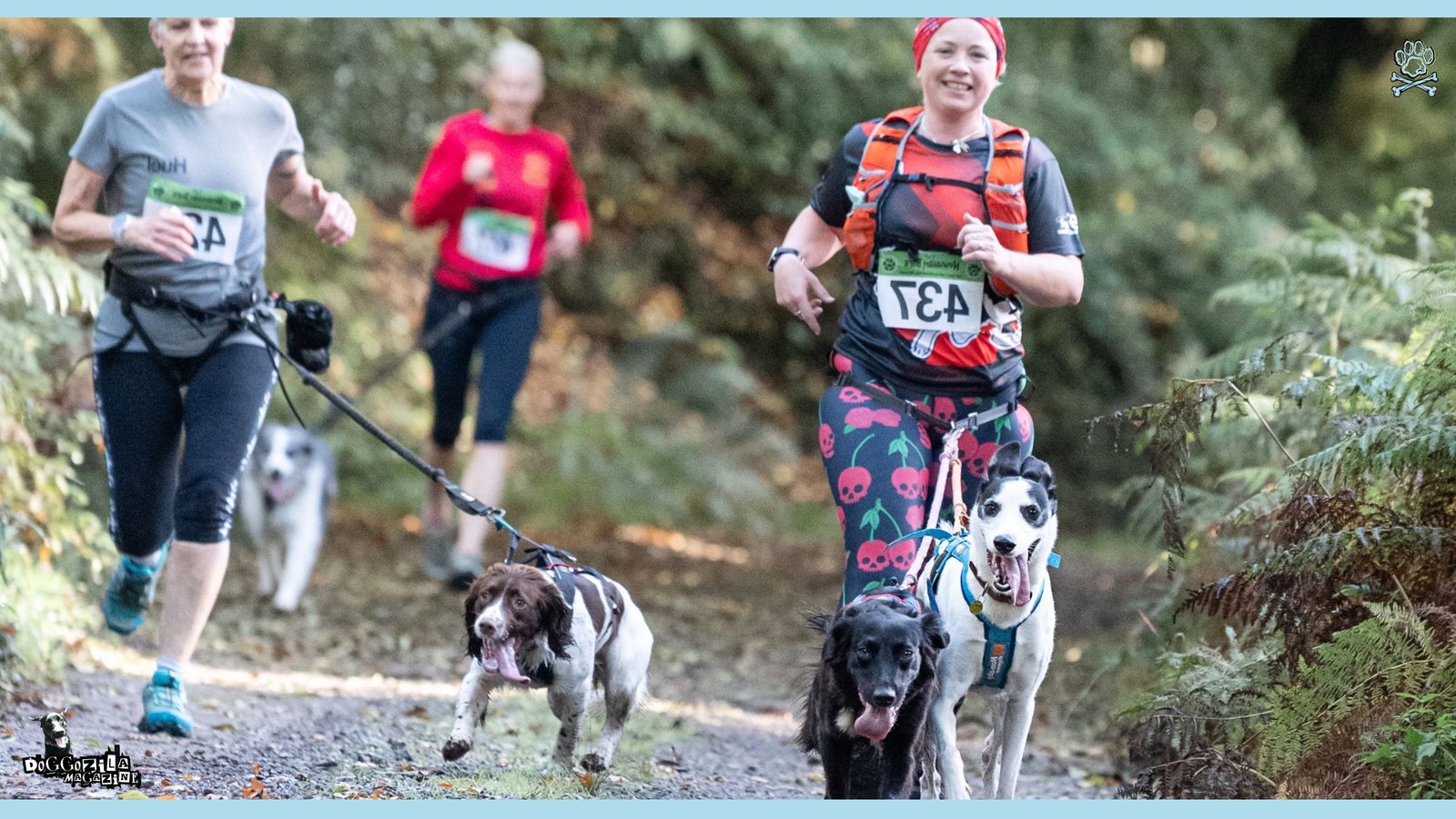
TRAINING FUNDAMENTALS FOR CROSS COUNTRY RUNNING WITH DOGS
Building a foundation for successful cross country running with dogs begins with basic obedience and leash manners. Before ever connecting via the canicross system, your dog should respond reliably to essential commands such as “stop,” “left,” “right,” and “leave it.” These commands become crucial for navigating trails safely and avoiding distractions. Dogs that pull excessively during regular walks may need additional training to understand the difference between casual walking and focused running. Remember that country running with dogs requires teamwork, not just physical endurance.
The transition to cross country running with dogs should be gradual, especially if you or your dog are new to endurance exercise. Begin with short distances at a slow pace, gradually increasing both as your fitness improves. Monitor your dog closely for signs of fatigue, overheating, or discomfort, and remember that dogs often don’t know their own limits, it’s your responsibility to set appropriate boundaries. Vary your terrain and intensity to build overall strength and prevent boredom. The key to successful country running with dogs is progressive adaptation that respects both partners’ capabilities.
What Are The Specific Canicross Commands?
Teaching specific canicross commands is essential for safe and enjoyable cross country running with dogs. While you can use standard obedience cues, many enthusiasts prefer traditional mushing terms like “hike” (go), “whoa” (stop), “gee” (right), and “haw” (left). Consistency is more important than the specific words chosen.
Practice these commands during regular walks before incorporating them into running sessions with your dog. Remember that many dogs excel at associating words with actions when rewarded consistently, making country running with dogs an excellent opportunity for bonding through clear communication.
Building Dog Endurance Safely
When preparing for cross country running with dogs, remember that canine athletes need conditioning just like human athletes. Start with a veterinarian check-up to ensure your dog is physically ready for exercise. Begin with short, slow runs of half a mile to a mile, gradually increasing distance by no more than 10% per week.
Pay attention to surface conditions, hard surfaces like asphalt create more impact than trails. Dogs should be at least 18 months old (24 months for giant breeds) before beginning serious country running with dogs to allow their growth plates to fully close.
Mastering Directional Commands
Effective communication is the heart of enjoyable cross country running with dogs. Directional commands allow you to navigate trails safely without breaking stride. Practice in controlled environments before hitting the trails, using positive reinforcement when your dog responds correctly.
Many dogs naturally learn to interpret body language and verbal cues when consistently paired with actions. The partnership developed through mastering these commands transforms country running with dogs from simple exercise to a harmonious dance between species.
Socialization and Trail Etiquette
An often-overlooked aspect of cross country running with dogs is proper trail etiquette. Your dog should be socialized to ignore distractions such as other dogs, wildlife, and people while running. Teach a reliable “on by” command for passing distractions without interaction.
Always yield to other trail users, and be prepared to step off the trail with your dog when necessary. Keep your dog under control at all times, not everyone appreciates an enthusiastic dog athlete approaching them. Responsible behavior ensures that country running with dogs remains welcome on trails.
🔑 Key Points: Success in canicross is built on a foundation of basic obedience, gradual conditioning, and teaching specific directional commands to ensure safe and harmonious teamwork on the trails.
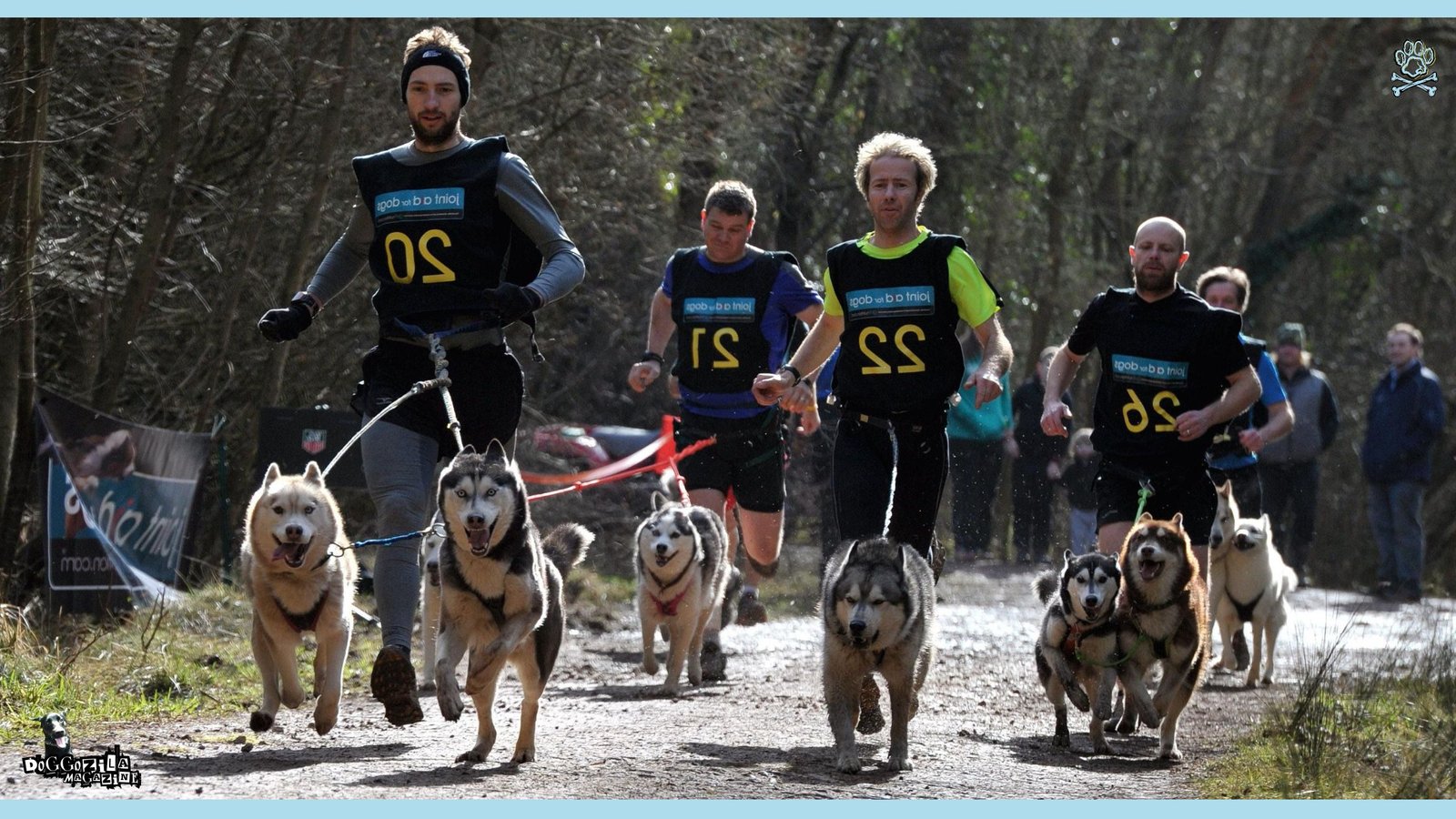
IDEAL BREEDS FOR CROSS COUNTRY RUNNING WITH DOGS
While the canicross community embraces an “any breed, any speed” philosophy, some breeds are naturally better suited for cross country running with dogs due to their physical structure, endurance capabilities, and instinctual drives.
When considering cross country running with dogs, it’s important to remember that mixed breeds can be excellent candidates too. Many shelters dogs with unknown heritage demonstrate tremendous aptitude for the sport. European enthusiasts have even developed purpose-bred mixes like Eurohounds (Alaskan Husky/Pointer crosses) and Greysters (German Shorthaired Pointer/Greyhound crosses) specifically for canicross competitions. These dogs combine endurance, speed, and temperature tolerance that make them ideal for country running with dogs at all levels.
What Are The Most Usual Breeds In Canicross?
Traditional sled dog breeds like Siberian Huskies and Alaskan Malamutes excel at pulling and have incredible endurance, though they may struggle in warmer climates. Sporting breeds such as German Shorthaired Pointers, Vizslas, and Labrador Retrievers bring enthusiasm and athleticism to country running with dogs, with physical traits that support sustained activity.
Herding breeds like Border Collies and Australian Shepherds are exceptional candidates for cross country running with dogs due to their work ethic, intelligence, and stamina. These breeds thrive when given a job to do and often excel at the teamwork required by canicross.
However, their intensity requires careful management to prevent overexertion. Smaller breeds such as Terriers can also participate in country running with dogs, though their shorter strides mean they’ll cover more ground relative to their size. The key is matching distance and intensity to each dog’s capabilities.
Siberian Huskies: Born for Cross Country Running with Dogs
Siberian Huskies are arguably the classic breed for cross country running with dogs, bred for centuries to pull loads over long distances. Their thick double coat protects them in cold conditions, though it can be challenging in warmer weather.
Huskies possess remarkable endurance and a natural pulling instinct that makes them enthusiastic partners for country running with dogs. They typically have a steady pace rather than explosive speed, ideal for long-distance trails. Their pack mentality makes them excellent team players in the human-canine partnership of canicross.
Related Article Recommendation:
Skijoring with Dogs: Complete Guide for Winter Adventures
Border Collies: The Intelligent Choice for Cross Country Running with Dogs
Border Collies bring exceptional intelligence and work ethic to cross country running with dogs. Their athletic build, stamina, and desire to please make them outstanding canicross partners. As demonstrated in the story of Eli Neztsosie and his Border Collie Tractor, these dogs can navigate challenging terrain with intelligence and awareness.
However, research shows Border Collies have a higher injury rate in dog sports compared to other breeds, so careful conditioning is essential for country running with dogs. Their mental stimulation needs are as important as physical exercise, making the strategic aspect of canicross particularly satisfying for this breed.
German Shorthaired Pointers: The All-Around Athletes
German Shorthaired Pointers are versatile athletes perfectly suited for cross country running with dogs. Bred as hunting dogs capable of working all day in various terrains, they possess the endurance, speed, and drive that excel in canicross.
Their short coat helps them regulate temperature better than thick-coated breeds, making them adaptable to various climates. As the science behind their athleticism reveals, German Shorthaired Pointers have genetic traits that support lean muscle mass, cardiovascular efficiency, and mental focus, all essential for country running with dogs.
🔑 Key Points: While many breeds can participate, Siberian Huskies, Border Collies, and German Shorthaired Pointers are among the breeds naturally well-suited for the sport due to their endurance, build, and instinctual drives.
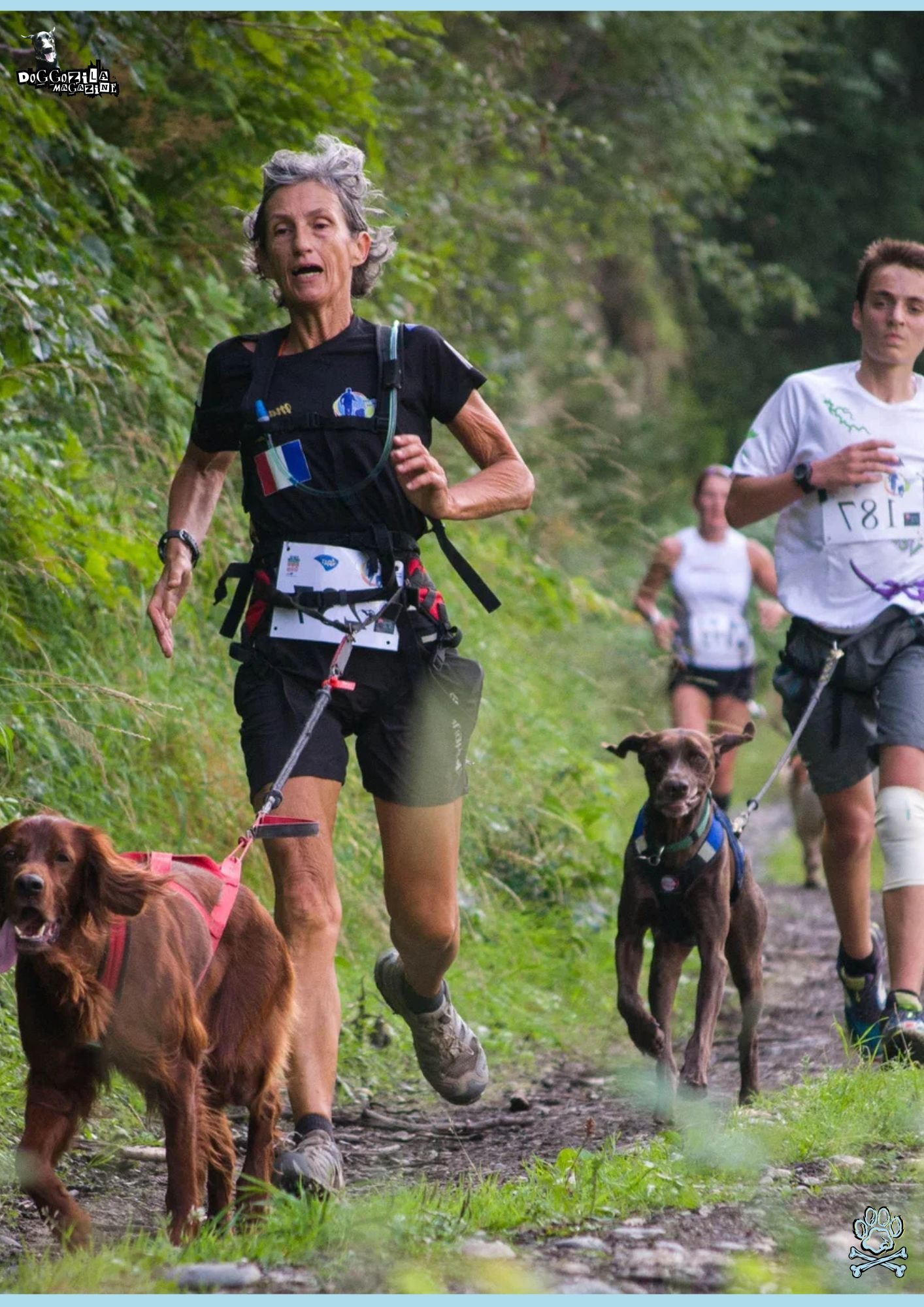
BUILDING STAMINA FOR COUNTRY RUNNING WITH DOGS
Developing endurance for cross country running with dogs requires a systematic approach that considers both human and canine fitness levels. Remember that country running with dogs is a partnership, both members need to develop stamina at a pace that respects their individual starting points.
Begin with a baseline assessment of your current running ability and your dog’s condition, then create a progressive training plan that gradually increases distance and intensity. Incorporate rest days to allow for recovery and tissue adaptation. Cross-training activities like swimming can build fitness without impact stress.
What You Need To Keep Your Furry Partner Safe While in Top Form?
Monitoring your dog’s response to cross country running with dogs training is essential for preventing overtraining and injury. Learn to recognize signs of fatigue such as excessive panting, lagging behind, or changed gait. Check paws regularly for wear or damage, especially when transitioning to new surfaces. Keep a training log that records distance, pace, terrain, weather conditions, and your dog’s recovery rate.
This data will help you identify optimal training loads for country running with dogs and notice potential issues before they become serious problems. Nutrition and hydration play critical roles in building stamina for cross country running with dogs. Active canine athletes have higher caloric and water requirements than sedentary pets.
Consult with your veterinarian about appropriate nutrition for your dog’s activity level, and adjust feeding schedules around training sessions. Always provide access to water before and after runs, and bring water on longer outings. Learning about canine hydration and energy needs will significantly enhance your country running with dogs’ experience and keep your partner healthy and energized.
Progressive Training Plans for Cross Country Running with Dogs
A structured approach is key to developing endurance for cross country running with dogs. Begin with walk-run intervals that gradually increase running segments while decreasing walking recovery periods. For most teams, a 10% weekly increase in total distance is a safe progression rate.
Include variety in your training with different terrains, elevations, and paces to build overall fitness. Periodize your training with easier recovery weeks every 3-4 weeks to allow adaptation. This systematic approach to country running with dogs prevents plateaus and reduces injury risk.
Recognizing and Preventing Overtraining
Vigilance is essential when building stamina for cross country running with dogs. Dog overtraining signs include decreased performance, lethargy, weight loss, and behavioral changes. More serious indicators like lameness, vomiting, or diarrhea require immediate veterinary attention.
Environmental factors like temperature and humidity dramatically affect dogs’ exercise tolerance, adjust your expectations accordingly. Learning to read your individual dog’s signals makes country running with dogs safer and more enjoyable. Remember that dogs will often push beyond their limits to please their humans, so conservative training is wise.
Related Article Recommendation:
Dog Sports: Ancient Origins to Modern Competitions
Nutrition for Canine Athletes in Cross Country Running with Dogs
Proper fueling transforms cross country running with dogs from exhausting to exhilarating. High-quality protein supports muscle repair, while appropriate fats provide sustained energy for endurance activities. Time meals carefully, as running on a full stomach can cause discomfort or more serious conditions like bloat in deep-chested breeds.
Post-run nutrition is equally important for recovery. Consult with your veterinarian about supplements that might benefit your canine athlete. Understanding nutritional science elevates your country running with dogs’ experience from simple exercise to optimized performance.
🔑 Key Points: Developing endurance for both partners requires a progressive, systematic training plan that carefully increases distance and intensity while prioritizing proper nutrition, hydration, and rest to prevent injury.
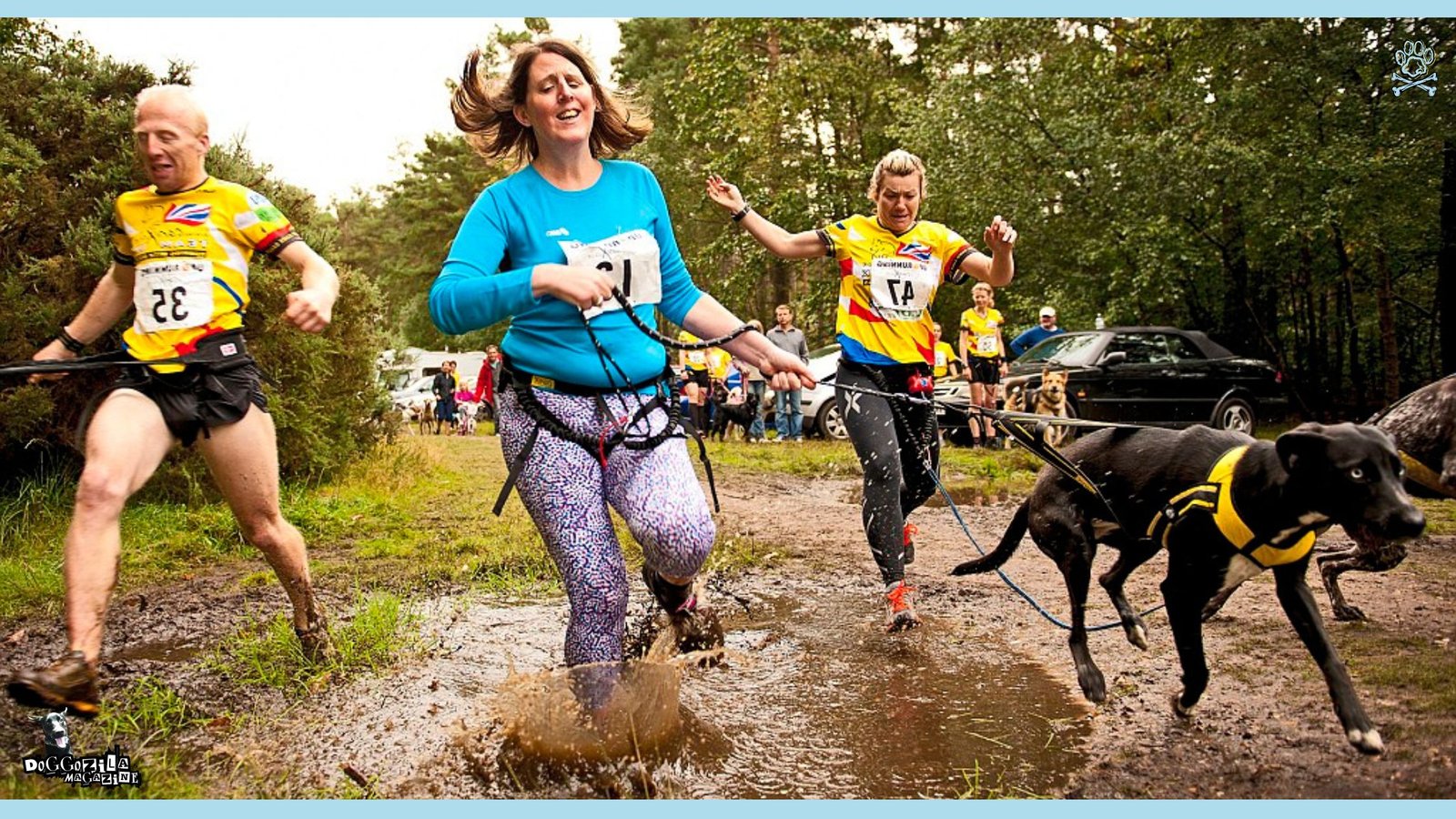
SAFETY CONSIDERATIONS FOR CROSS COUNTRY RUNNING WITH DOGS
Weather awareness is crucial for safe cross country running with dogs. Unlike humans, dogs cannot efficiently cool themselves through sweating and rely primarily on panting to regulate body temperature.
Research shows that certain breeds like Border Collies have higher injury rates in athletic activities, so breed-specific precautions are wise. Regular veterinary check-ups that include discussion of your cross country running with dogs’ routine can identify potential issues before they become serious problems.
What You Need To Do To Protect Your Dog for This Sport?
Avoid running during the hottest parts of the day, and learn to recognize signs of heat stress such as excessive panting, bright red gums, or stumbling. In cold weather, watch for signs of hypothermia like shivering or lethargy. Paw protection may be necessary in extreme temperatures, either booties for hot pavement or icy conditions, or paw wax to protect from abrasion during country running with dogs.
Understanding canine anatomy and common injuries will help you practice cross country running with dogs more safely. Learn to recognize limping or changed gait patterns that might indicate musculoskeletal issues. Common running injuries in dogs include shoulder strains, iliopsoas injuries, and paw pad abrasions.
Emergency preparedness is an often-overlooked aspect of cross country running with dogs. Always carry a basic first aid kit that includes supplies for both human and canine needs. Know how to perform basic emergency care for your dog, including how to manage bleeding, protect injured limbs, and recognize signs of serious distress.
Identification is crucial, ensure your dog’s microchip information is current and that they wear a tag with your contact information during country running with dogs’ adventures. These precautions provide peace of mind when exploring remote trails together.
Temperature Management During Cross Country Running with Dogs
Thermoregulation is perhaps the most critical safety aspect of cross country running with dogs. Dogs can suffer heatstroke at temperatures humans find comfortable, with brachycephalic breeds (short-nosed) being particularly vulnerable.
Schedule runs during cooler parts of the day in warm weather, and choose shaded trails when possible. Learn your dog’s normal breathing patterns so you can recognize concerning changes. Cooling vests, frequent water breaks, and wetting your dog’s coat can help manage temperature during country running with dogs in warm conditions.
Trail Hazards and Avoidance Strategies
Risk awareness enhances safety during running sessions with your dogs. Familiarize yourself with regional hazards such as toxic plants, wildlife concerns, or terrain challenges. Keep your dog on the designated trail to avoid ticks, sharp rocks, or other dangers.
Train a reliable “leave it” command to prevent your dog from investigating potentially dangerous items. During hunting seasons, consider avoiding wooded areas or using high-visibility gear for both of you. These precautions make country running with dogs safer while preserving the joy of exploration.
First Aid Essentials for Cross Country Running with Dogs
Preparation transforms emergencies during cross country running with dogs from catastrophes to manageable situations. Your canine first aid kit should include, self-adhesive bandages, antiseptic wipes, tweezers for removing debris, a digital thermometer, and styptic powder for nail injuries.
Know how to check your dog’s vital signs and establish baselines when they’re healthy. Taking a pet first aid course specifically focused on athletic injuries will build confidence for your canicross adventures. Remember that prevention is the best medicine, proper conditioning and gradual progression prevent most issues.
🔑 Key Points: The most critical safety factor is temperature management, as dogs are highly susceptible to overheating; runners must also be aware of trail hazards and carry a canine-specific first aid kit.
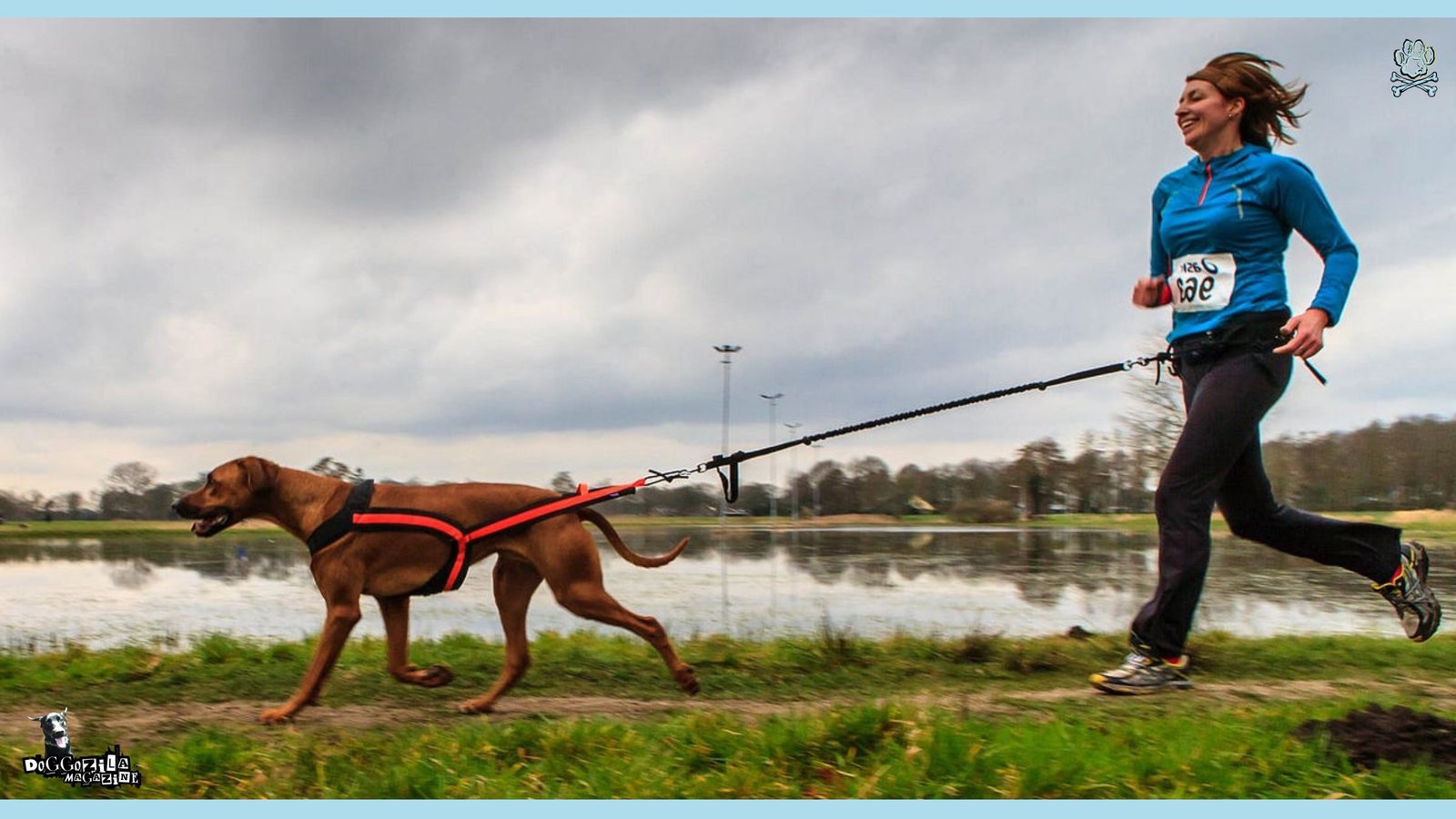
CASE STUDIES: SUCCESSFUL CANICROSS PARTNERSHIPS
The transformative power of cross country running with dogs is beautifully illustrated by the story of Eli Neztsosie and his Border Collie Tractor. As a Navajo rancher living in isolation, Eli struggled with health issues and depression following a serious accident. His unexpected journey into running began when he spontaneously broke into a jog during a walk with Tractor, discovering that the activity provided relief from his physical and emotional pain. Within weeks, they progressed to longer distances, and soon Eli was competing in ultras, all with Tractor by his side, both as running partner and navigator on treacherous terrain.
Research studies provide valuable insights into optimizing canicross partnerships. A 2024 study focusing on Border Collies in agility, a related dog sport revealed important injury risk factors that can inform canicross training approaches. The research found that jump height relative to shoulder height, early introduction to high-impact activities, and competition frequency all influenced injury rates. These findings suggest that cross country running with dogs participants should consider breed-specific conditioning, avoid excessive training volumes, and wait until musculoskeletal maturity before introducing intense training.
The Canicross Community Insights
The community aspect of cross country running with dogs creates powerful support networks that extend beyond the sport itself. Many participants report that their canicross relationships have helped them through difficult life circumstances, providing structure, social connection, and emotional support.
Dogs often sense when their human partners are struggling, offering motivation on days when enthusiasm wanes. These deep bonds, forged through shared physical challenge and mutual dependence, represent the heart of what makes country running with dogs so much more than just exercise.
From Recovery to Ultra Running: Eli and Tractor’s Story
The journey of Eli and Tractor exemplifies the healing potential of cross country running with dogs. Following a dirt bike accident that left him with seizures and depression, Eli discovered that running with his Border Collie provided both physical and mental relief.
Their partnership evolved from tentative jogs to ultrarunning accomplishments, with Tractor often leading the way through dangerous terrain in the Arizona desert. This case study demonstrates how canicross can build not just fitness, but profound interspecies trust and companionship.
Research Insights on Canine Athletic Performance
Scientific investigation enhances our understanding of cross country running with dogs. The 2024 study on Border Collie injuries in agility competitions revealed that dogs jumping noticeably above or below shoulder height had increased injury risk, suggesting that appropriate obstacle height is crucial for safety.
The study also found that beginning elbow-height jumps before 10 months of age increased injury risk, highlighting the importance of waiting until skeletal maturity before intense training. These findings help canicross enthusiasts make evidence-based decisions about training their canine partners.
The Social Pack: Community Benefits of Cross Country Running with Dogs
Beyond individual partnerships, cross country running with dogs creates communities that support both human and canine well-being. Group runs provide socialization opportunities for dogs and people alike, combating isolation and loneliness. Training groups share knowledge about proper technique, injury prevention, and local trails.
This community aspect is particularly valuable for people experiencing life transitions or mental health challenges, offering structure and social connection through country running with dogs. The pack mentality extends beyond species lines, creating inclusive communities centered around shared activity.
🔑 Key Points: Real-world examples, like the story of Eli and his dog Tractor, demonstrate that canicross offers profound benefits that extend beyond physical fitness to include mental well-being and deep interspecies bonding.
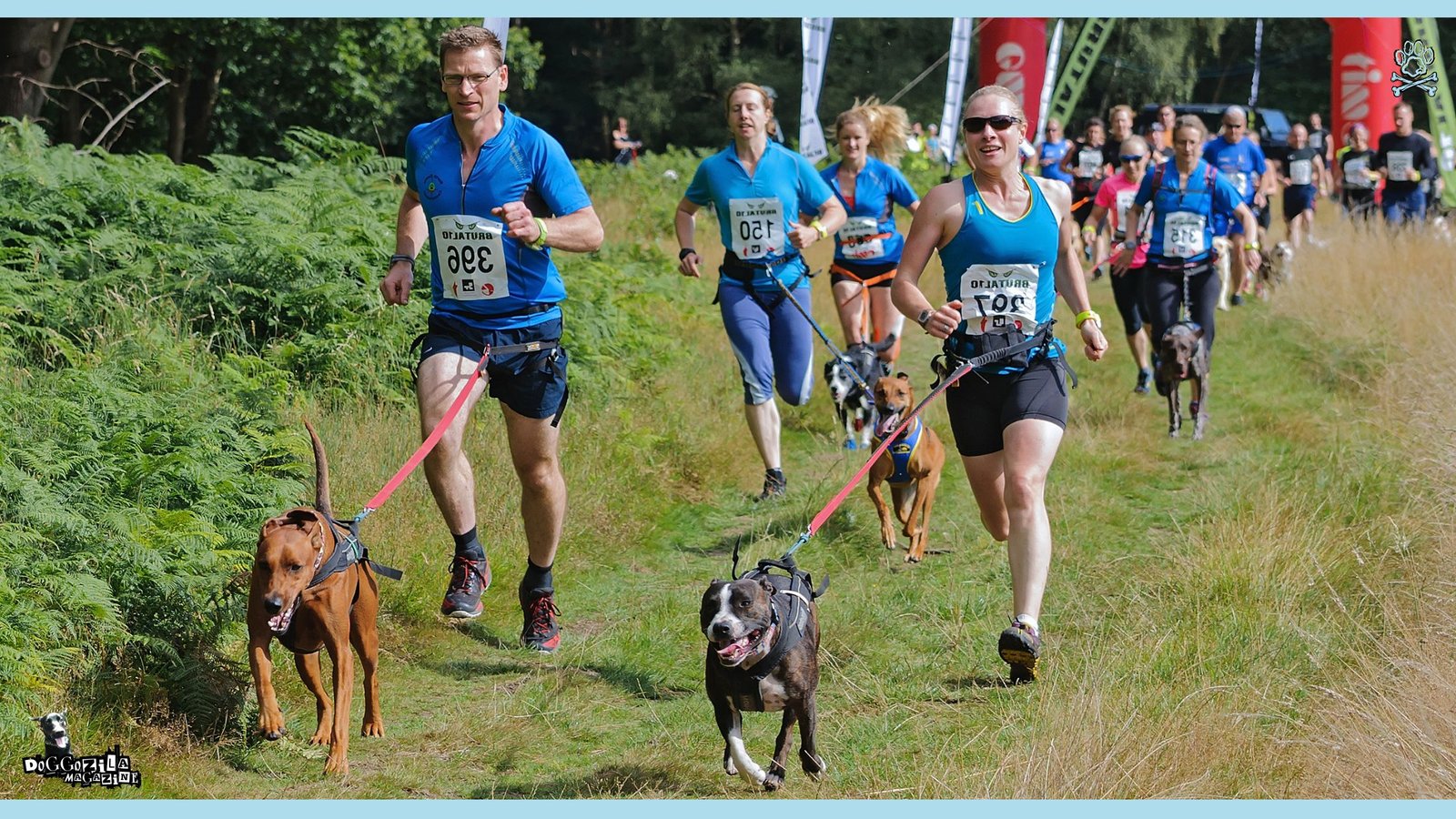
BEGINNER’S 5K CANICROSS TRAINING PLAN
Embarking on your canicross journey requires a structured approach that gradually builds fitness while prioritizing safety and enjoyment. This 8-week training plan is designed to transform complete beginners into teams capable of completing a 5K (3.1 miles) together. The plan assumes both human and dog are initially sedentary but healthy, with veterinarian clearance for the dog to participate. Each week includes three running days, two cross-training days, and two rest days for recovery.
The foundation of successful canicross is consistency rather than intensity. During the first two weeks, focus on establishing a routine and teaching basic commands rather than covering distance. If either partner shows signs of excessive fatigue, repeat a week before progressing. Always begin with a 5-minute warm-up walk and end with a 5-minute cool-down walk.
Always Document Progress and Celebrate Milestones
The cross country running with dogs experience should be positive for both species, so keep sessions short and rewarding, especially in the early stages of training. Tracking your progress in canicross provides motivation and valuable information about your team’s development. Keep a simple log that records distance, time, weather conditions, and notes about your dog’s energy level and attitude.
This documentation will help you identify patterns and make adjustments to your training approach. Celebrate milestones along the way, your first continuous mile, your first trail run, your first 5K. These celebrations reinforce the positive aspects of country running with dogs and strengthen your bond through shared accomplishment. Remember that cross country running with dogs is about partnership, so adjust the plan based on your team’s specific needs and responses.
Weeks 1-2: Building a Foundation for Cross Country Running with Dogs
The initial phase of canicross focuses on establishing routines and introducing equipment. During these two weeks, use your running sessions to practice walking with the canicross gear while introducing basic commands.
Session structure: 5-minute warm-up walk, then alternate 1 minute of slow jogging with 3 minutes of walking for 20 minutes total, finishing with a 5-minute cool-down walk. Focus on teaching “hike” (go), “whoa” (stop), and “easy” (slow down). These foundation weeks for country running with dogs create communication patterns that will ensure safety and enjoyment as distances increase.
Weeks 3-6: Gradually Increasing Distance for Cross Country Running with Dogs
The middle phase of canicross training builds endurance through progressive overload. Each week, slightly increase running intervals while decreasing walking recovery. By week 6, you should be able to run for 10 minutes continuously with just brief walking breaks.
Session structure: 5-minute warm-up walk, then progressively longer run/walk intervals totaling 25-30 minutes, finishing with a 5-minute cool-down walk. During this phase of country running with dogs, pay close attention to your dog’s recovery and enthusiasm, adjusting pace and distance based on their response.
Weeks 7-8: Preparing for Your First 5K Cross Country Running with Dogs
The final phase of canicross training prepares you for continuous running over 5K distance. In week 7, focus on building endurance with longer running intervals, and in week 8, incorporate a practice 5K run at the beginning of the week followed by tapered sessions leading to your goal event.
Session structure: 5-minute warm-up walk, 20-30 minutes of continuous running, 5-minute cool-down walk. Remember that your first country running with dogs 5K is about completion, not competition, but focus on positive experiences rather than speed.
🔑 Key Points: A structured, gradual 8-week training plan is recommended for beginners, focusing on consistency, positive experiences, and slowly building up to a 5K distance to ensure a safe and enjoyable start to the sport.
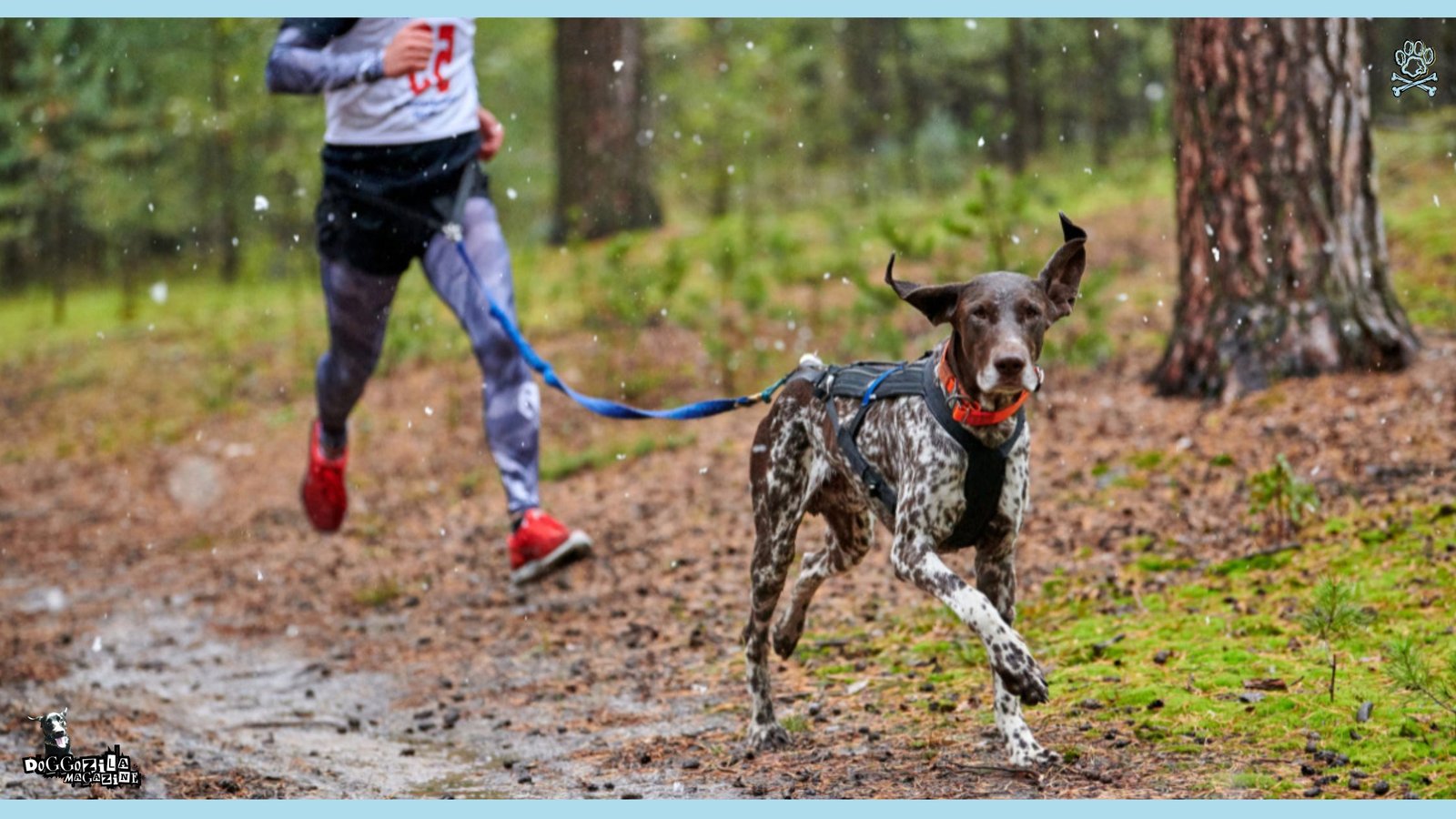
EMBRACING THE COUNTRY RUNNING WITH DOGS LIFESTYLE
Canicross offers a unique opportunity to combine fitness, companionship, and adventure in a single activity. Whether you’re jogging through local parks or competing in organized canicross events, the sport strengthens the bond between human and dog through shared challenge and accomplishment.
The benefits extend far beyond physical health, encompassing mental well-being, social connection, and the deep satisfaction of collaborating across species lines. As you embark on your cross country running with dogs journey, remember that the goal is not just miles covered but relationship built.
The Final Takeaway
The path to successful cross country running with dogs requires patience, knowledge, and attention to both partners’ needs. Invest in proper equipment, build fitness gradually, and prioritize safety in all conditions. Learn to read your dog’s signals and respond appropriately, creating a dialogue that enhances your teamwork. Draw inspiration from the stories of other canicross teams while recognizing that your journey will be unique.
The cross country running with dogs community continues to grow because the sport delivers something remarkable: the chance to experience the world through motion together. As you progress in your cross country running with dogs practice, you’ll discover that the sport is about more than exercise, it’s a way of being with your dog that honors their capabilities and deepens your connection.
The trails you explore together become maps of shared experience, each mile strengthening your partnership. Whether you continue with casual runs or progress to competitive events, country running with dogs will change how you view your canine companion, transforming them from pet to athlete and teammate.
The finish line is just the beginning of a lifelong adventure.
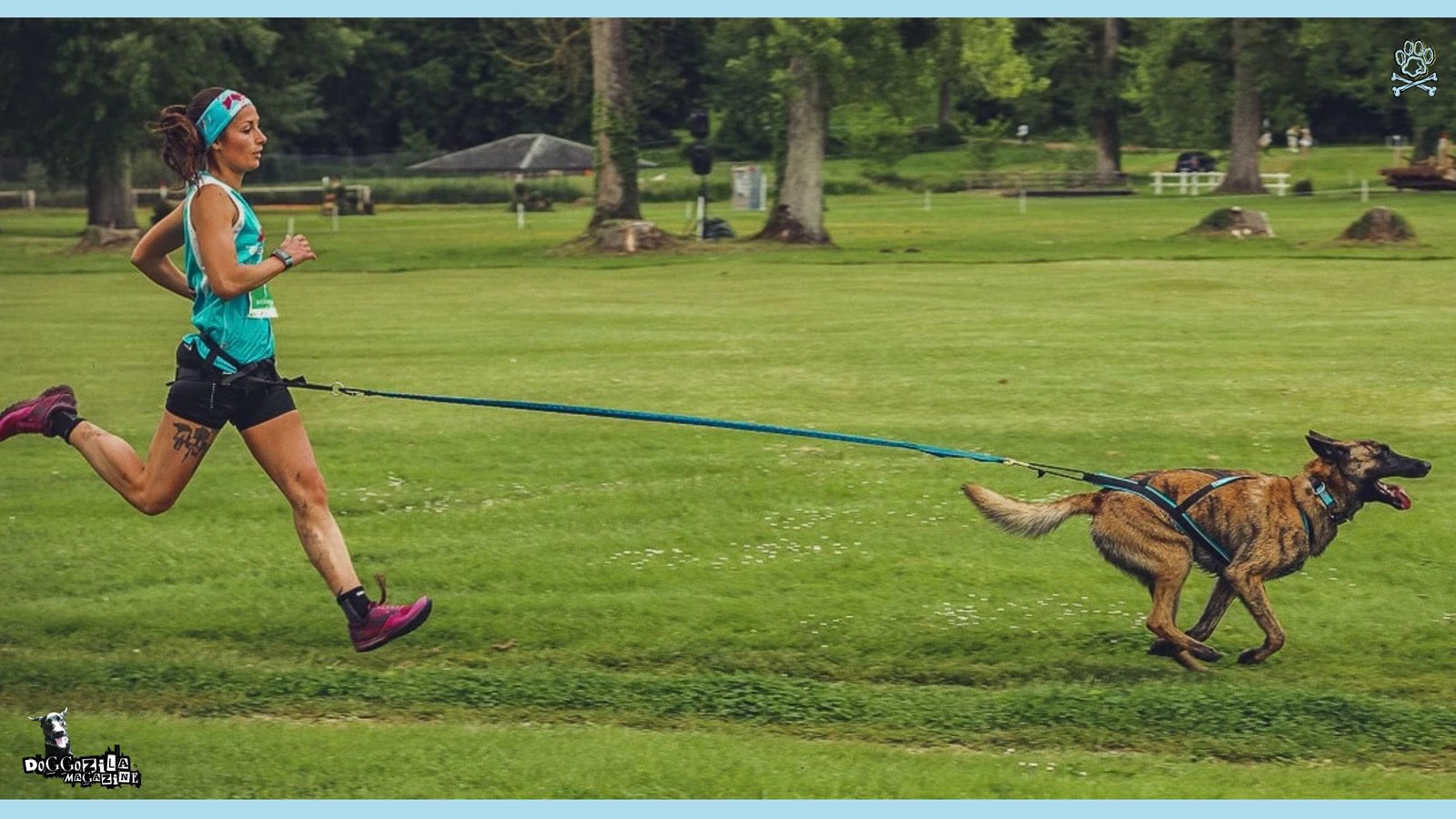
Forget the leash, imagine a harness, a shared rhythm, and the trail ahead calling to both of you!




